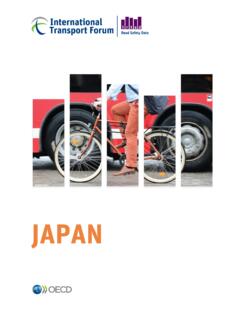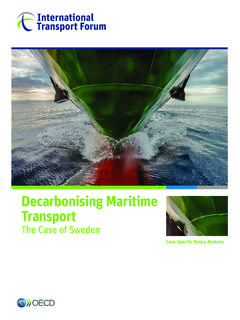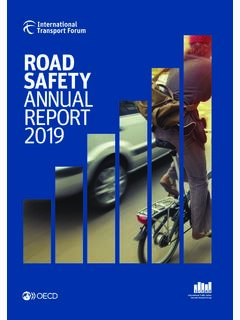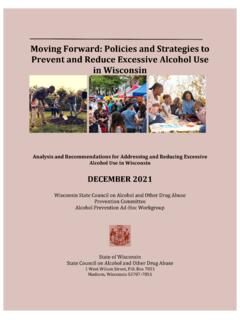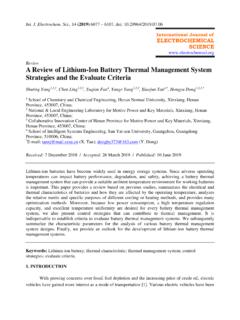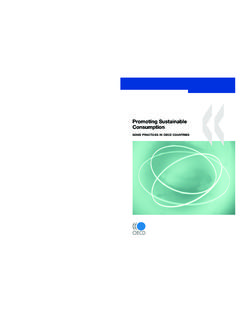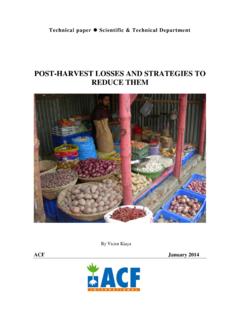Transcription of Strategies to Reduce Greenhouse Gas Emissions from Road ...
1 Strategies to Reduce Greenhouse Gas Emissions from Road Transport: Analytical Methods Road transport accounts for approximately 80% of CO2 Emissions emanating from transport, which corresponds to more than 20% of total Emissions . This clearly has enormous implications for global climate change. What are the measures and Strategies already taken by OECD countries to Reduce or stabilise Greenhouse gases from road transport? What frameworks exist to evaluate the impact and efficiency of these measures and Strategies ? And how effective are they? With the continued growth forecast in car ownership and distance travelled, what are the expected trends in CO2 Emissions and their consequences for the potential achievement of the Kyoto Protocol?
2 What models are available to predict the level of CO2 Emissions ? Are they useful? This report, which has been prepared by an OECD Working Group, uses a number of illustrative and pragmatic cases to provide important insights into these major questions.. Strategies to Reduce Greenhouse Gas Emissions from Road Transport: Analytical Methods OECD's books, periodicals and statistical databases are now available via , our online library. This book is available to subscribers to the following SourceOECD themes: Environment and Sustainable Development Transport Ask your librarian for more details on how to access OECD books on line, or write to us at ISBN 92-64-19678-1.
3 77 2002 01 1 P. -:HSTCQE=V^[\]U: OECD, 2002. Software: 1987-1996, Acrobat is a trademark of ADOBE. All rights reserved. OECD grants you the right to use one copy of this Program for your personal use only. Unauthorised reproduction, lending, hiring, transmission or distribution of any data or software is prohibited. You must treat the Program and associated materials and any elements thereof like any other copyrighted material. All requests should be made to: Head of Publications Service, OECD Publications Service, 2, rue Andr -Pascal, 75775 Paris Cedex 16, France.
4 Strategies to Reduce Greenhouse Gas Emissions from Road Transport: Analytical Methods ORGANISATION FOR ECONOMIC CO-OPERATION AND DEVELOPMENT. ORGANISATION FOR ECONOMIC CO-OPERATION. AND DEVELOPMENT. Pursuant to Article 1 of the Convention signed in Paris on 14th December 1960, and which came into force on 30th September 1961, the Organisation for Economic Co-operation and Development (OECD). shall promote policies designed: to achieve the highest sustainable economic growth and employment and a rising standard of living in Member countries, while maintaining financial stability, and thus to contribute to the development of the world economy.
5 To contribute to sound economic expansion in Member as well as non-member countries in the process of economic development; and to contribute to the expansion of world trade on a multilateral, non-discriminatory basis in accordance with international obligations. The original Member countries of the OECD are Austria, Belgium, Canada, Denmark, France, Germany, Greece, Iceland, Ireland, Italy, Luxembourg, the Netherlands, Norway, Portugal, Spain, Sweden, Switzerland, Turkey, the United Kingdom and the United States. The following countries became Members subsequently through accession at the dates indicated hereafter: Japan (28th April 1964), Finland (28th January 1969), Australia (7th June 1971), New Zealand (29th May 1973), Mexico (18th May 1994), the Czech Republic (21st December 1995), Hungary (7th May 1996), Poland (22nd November 1996), Korea (12th December 1996) and the Slovak Republic (14th December 2000).
6 The Commission of the European Communities takes part in the work of the OECD (Article 13 of the OECD. Convention). Publi en fran ais sous le titre : Strat gies de r duction des gaz effet de serre manant du transport routier : m thodes d'analyse OECD 2002. Permission to reproduce a portion of this work for non-commercial purposes or classroom use should be obtained through the Centre fran ais d'exploitation du droit de copie (CFC), 20, rue des Grands-Augustins, 75006 Paris, France, tel. (33-1) 44 07 47 70, fax (33-1) 46 34 67 19, for every country except the United States.
7 In the United States permission should be obtained through the Copyright Clearance Center, Customer Service, (508)750-8400, 222 Rosewood Drive, Danvers, MA 01923 USA, or CCC Online: All other applications for permission to reproduce or translate all or part of this book should be made to OECD Publications, 2, rue Andr -Pascal, 75775 Paris Cedex 16, France. FOREWORD. The Mission of the OECD Programme of Research on Road Transport and Intermodal Linkages (RTR) Programme is to promote economic development in its Member countries by enhancing transport safety, efficiency and sustainability through a co-operative research programme on road and intermodal transport.
8 To achieve this objective, the Programme recommends options for the development and implementation of effective transport policies for Members, and encourages outreach activities for non- member countries. All 30 OECD Member countries participate in the Programme. The 1998-2000 Programme of Work included a Working Group on Analytical Methods of Road Transport Sector Strategies to Reduce Greenhouse Gas Emissions . The Working Group was chaired by Mr. Jean Delsey (INRETS, France) and the following countries participated in the study: Australia, Canada, Czech Republic, Denmark, France, Hungary, Italy, Japan, Korea, the Netherlands, New Zealand, Norway, Switzerland, the United Kingdom and the United States.
9 The Working Group investigated recent trends in CO2 Emissions from road transport, and reviewed models that have been developed by OECD Member countries to forecast Greenhouse gas Emissions from road transport. In addition, the Working Group analysed models that have been used to assess policy options to Reduce CO 2 Emissions and provide insight on future developments. 3. OECD 2002. ABSTRACT. ITRD No. E109210. Approximately 27% of total OECD CO 2 Emissions come from transport. Within this, road-based transport accounts for approximately 80%. The OECD Road Transport and Intermodal Linkages Research Programme established a Working Group to undertake a comprehensive study on CO2 Emissions from road transport, with the aim of providing a useful framework for assessing the Strategies of the road transport sector in reducing Emissions on a global scale.
10 The Kyoto Protocol seeks an average reduction in economy-wide Greenhouse gases Emissions compared to 1990 levels in industrialised countries and countries in transition (Annex I parties to the UN Framework Convention on Climate Change) by 2008-12. Given recent developments in transport growth, it would be very challenging for the road transport sector in OECD countries to achieve substantial reductions in CO2 Emissions over the same period. However, measures exist that can contribute to alleviate the road transport share of Greenhouse gases. The most effective approach to reducing GHG Emissions by private cars and road transport should involve a package or combination of measures, such as: voluntary agreement between vehicle manufacturers and government to produce low-fuel consumption vehicles; graduated vehicle taxes; fuel taxes and excise duties; consumer information; and promotion of greater fuel efficiency in the different sectors involved.
